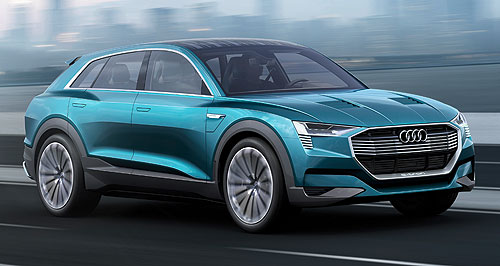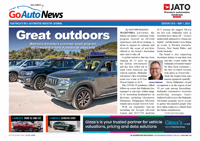Make / Model Search
News - AudiAI will help fight congestion: AudiIntelligence +10: Audi’s artificial intelligence systems will be used to communicate with other vehicles and infrastructure as a way of navigating and processing the environment for more efficient driving. Artificial intelligence to unlock future Audi computing power18 Jul 2017 By DANIEL DeGASPERI in BARCELONA AUDI will use artificial intelligence to underpin car-to-car and car-to-X communications as a way of combatting rising urbanization and traffic congestion on its way to its first fully autonomous car. Audi AG chief digital officer/chief strategy officer Dr Roland Villinger explained the magnitude of the task ahead for new vehicle manufacturers, with the company forecasting the number of global cities with 10 million inhabitants will grow from the current 23 to, “close to 40 by the middle of next decade”. “We all know that the number of mega cities, so cities with more than 10 million inhabitants is rising,” Dr Villinger said at the international reveal of the Audi A8 in Barcelona, Spain, last week. “City governments are struggling to connect the different modes of transportation for the benefit of their citizens (and) cars have to move from being a cause of problems, to being an enabler for future-oriented mobility.” Dr Villinger insisted that the task ahead was not merely about how to lower CO2 emissions in new vehicles to meet increasingly tight global legislation, but also grasping “the limitations of infrastructure in our cities (while) at the same time more and more people are moving into our cities”. Audi has stated that it will accelerate the move towards level five autonomous driving capability in order to unlock what it calls the “twenty-fifth hour” in a day for drivers. The company has said that it conducted research that showed a car owner would on average spend around 50 minutes in traffic congestion per day. But until steering wheel-less capability is released, Audi would aim to increase artificial intelligence in models starting with the A8, which can communicate with other so-equipped vehicles on the road to alert a driver of a collision ahead or traffic jam in real time – and allow the navigation system to re-route a course. Future Audis would communicate with traffic lights to save fuel, which in conjunction with the A8’s self-driving capability – up to 60km/h in divided freeway traffic jams only (see separate story) – were features that, the Ingolstadt brand believed, would distance premium manufacturers from each other. Speaking at the event, Audi AG chairman of the board of management Rupert Stadler declared: “Future premium means taking back control of you time, because time is one of the most valuable goods. “Audi plus intelligence plus forward thinking, this becomes Audi AI,” he continued. “It’s not about one car alone, it is about all partners in traffic altogether. Interconnected with each other, they form a so-called intelligence, and this results in the perfect flow on our streets. “Our customers expect more than others – the merge of the digital and real world. They stay connected with their vehicles, they still see individual mobility as a declaration of independence (and) they enjoy urban living in smart cities with seamless mobility. This is why we strategically aim at digitisation, sustainability and urbanisation. These are the three drivers for Audi Vorsprung 2025.” By 2025 Audi forecasts that one-third of its new models will offer hybridisation or full electric capability (see separate story) in conjunction with enhanced autonomous driving capabilities that have now started being rolled out. However, it could make the technology in the just-released A8 dated within two years. “This car (A8) provides a preview to our second electric car, which is due to come in 2019,” Audi AG member of the board of technology development Dr Peter Mertens said of Audi’s forthcoming E-tron Sportback large SUV. “It will even be more intelligent. I imagine a world where getting from A-to-B is a pleasure and time well spent. A world with fewer accidents, because powerful technology simply won’t let them happen. Where resources are put to use better than ever before (and) where emissions are reduced to zero. “(It will be) a world where people enjoy premium mobility.” The A8 debuts an entirely new computing architecture dubbed zFAS, complete with enhanced power fed by a 48-volt electrical system required to also operate a backup computer and a suite of sensors and radars around the vehicle. Mr Mertens revealed that it was the zFAS has been engineered to handle the progression of artificial intelligence and would flow into other future models. “Self-driving cars need artificial intelligence as one of the key technologies allowing them to really cope with the complexity of traffic,” he continued. “The core technology behind this vision starts with our central control unit, the zFAS, the dedicated super brain for all assistance systems. Almost in real time, data from various systems will be matched with data from infrastructure and other road users. “This is the enabler for level three of automated driving.” Dr Villinger also further expanded on the technology that Audi said would help drive its ‘premium mobility’ goals, headed by a new subsidiary of Audi called Autonomous Intelligent Driving GmBh. “Our traffic system connects urban traffic light systems with our cars, again for the benefit of lower CO2 emissions and a better flow of traffic,” he explained. “We are (now) thinking about what we’re doing about autonomous driving functions in an urban environment. We are (also) collaborating with urban stakeholders, city governments and others. “Autonomous Intelligent Driving GmBh will focus entirely on being a speed boat for Audi to move to level five autonomy. And it will have strayed towards the most complex of autonomous driving environments, which is urban traffic.” Urban traffic has been deemed the hardest operating environment for an autonomous vehicle to manage, not only because of the density of vehicles, variables of signage, pedestrian activity and cross-streets – but also the differences in such aspects in different global cities. Audi AG head of digitisation Dr John Newman said that: “I think it’s fair to say (we are) quite cognisant of difference in drive behaviours in different cities, in different regions. “So (we) see a solution that requires a tailored response. As we get to education between cars and infrastructure, cars and cars … over time you can make the process fully optimised. “(But) it’s not something that going to be solved at all places, at all times. “We have engineers that are consumed very day by looking at how do you actually create a safe and simplified premium automated driving experience.” That included, he revealed, poaching engineers from across the globe who are familiar with particular urban operating environments. “We are thinking very hard about how to use digitalisation to further improve the operating environment in which our vehicles are driven,” Dr Newman continued. “We’re taking a multi-geographic approach to finding the best people so we’re moving beyond Europe looking through our market (Germany), looking very intensively on how we can recruit the best talent from China, other parts of South-East Asia and then the Americas including both Brazil and other markets.”“We have a group in San Francisco that looking at quantum computing and they’ve used quantum computing now to optimise traffic flow across cities.” As a company goal for the future, however, Dr Newman made a statement that was simple and clear: “We will have been successful when we use digitalisation to make premium mobility effortless.”  Read more17th of July 2017  Tech has become too complex: AudiButtons flicked as future Audi touchscreens ape smartphone intuition14th of July 2017  Audi lists AI-infused future product planSeven new models by 2020 to score Audi AI intelligence tech |
Click to shareAudi articlesResearch Audi Motor industry news |











Facebook Twitter Instagram